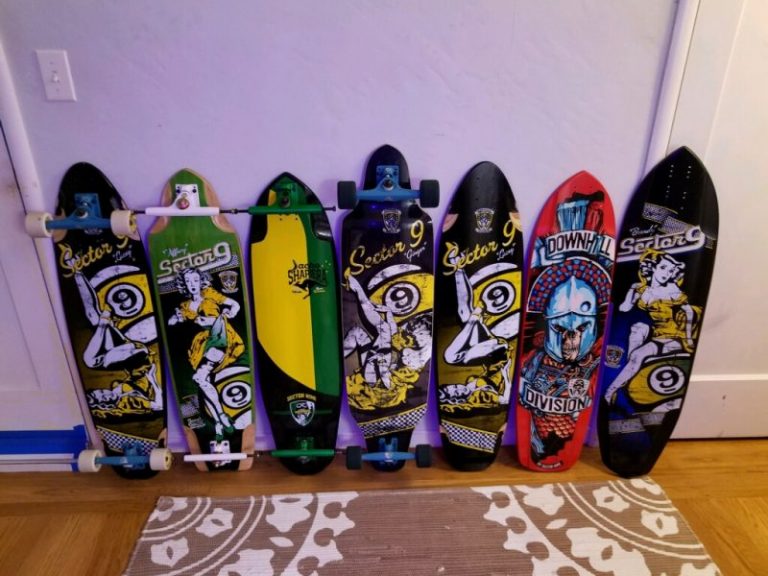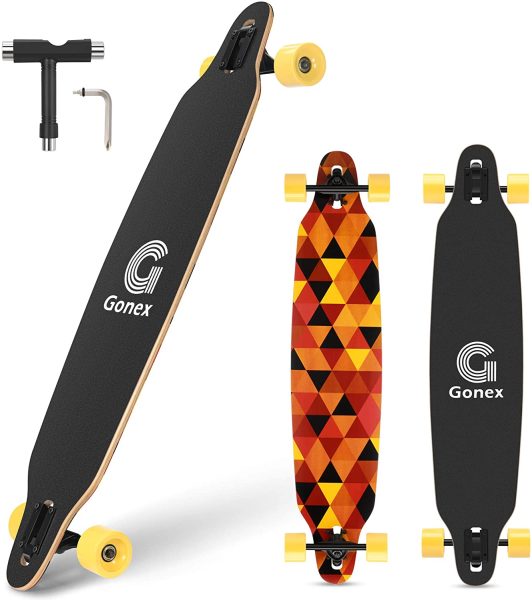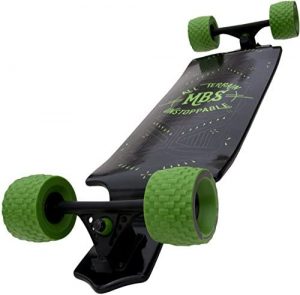Are you a beginner and want to know how to choose a longboard? Or being a Pro, you still struggle to find the longboard that suits your ride is a big deal? Skatevella has come across the solution to these issues.
Our team of experts is here for our readers after gaining their experience in a specified field. In this article, you will find the conclusive remarks and details from the hand on experience of our team.
What needs to be considered before buying a longboard:
- Riding Style
- Length of the Longboard and its Wheelbase
- Style, shape, and features of the deck
- Measurement of Trucks
- Size and type of Wheels
- The friction of these Bearings
- Flex
- Construction and composition of Material of longboard.

How to Choose a Longboard-Step by Step Guide
1. Longboard Riding Styles
If you want to have fun and stay safe on your longboard, make sure that the style of riding matches your surroundings. If it’s flat land or if there are a lot of hills nearby, then choose one for cruising through town or bombing down mountain slopes, respectively.
Cruising & Carving Longboarding
Longboarding can be an exhilarating and fun way to get around. Ripping downhills, flying through the quad on your way to class, or pulling a long-distance push; this type of riding will appeal most if you are just getting started with Longboards!
More details regarding cruising can be found in Our article on the best longboard for cruising.
Downhill Longboarding
As it’s clear from its name, downhill longboarding. This riding style is mainly for fast riding on hills while maintaining speed as well. The position for this is either the tucked position on the longboard. It is for reducing the wind resistance and is a more stable ride.
Freeride Longboarding
Freeriding on a longboard means that you are riding hills with speed while stylishly performing slides and curb hops, as well as the ability to control your downhill momentum when needed. This particular form of board-riding requires quite skilled footwork at high speeds, so it’s typically reserved for experts only.
Freestyle Longboarding
Freestyle longboarding is a great way to get creative and have fun. The skill sets range from sliding, tricks on your deck of cards (board), regular riding, as well as goofy style, which gives it its name because you can do anything that comes to mind while rolling down the street at the top speed.
Freeriding isn’t just for beginners – if there’s one type genuinely worth trying out, then this must be it; advanced riders will love how intensely challenging yet rewarding practicing these moves feels in both safety-conscious environments where accidents cannot happen or even worse consequences should they occur like landing hard enough against something so breakable without hurting yourself but rather having a fantastic display.
2. Length of the Longboard and its Wheelbase
First, you need to determine what size longboard will best fit your needs. There are three standard sizes: mini, cruiser, and downhill. Mini boards are usually for kids or those shorter than 5’6″.
Cruisers are suitable for relaxed cruising and commuting. Downhill boards have a kicktail at the back for maneuverability on hills and drops.
Now that you know what longboard is right for you, it’s time to consider shape. To know better how to choose a longboard here is the size chart
| Style | Longboard Size according to the Height of the Rider |
Cruising | Up to 5’10” Rider use 32-40″ |
| 5’10″+ Rider use 40″+ | |
Downhill | Up to 5’10” Riders use 35-42″ |
| 5’10″+ Riders use 42″+ | |
| Freeride & Freestyle | Up to 5’10” Rider use 38-42″ |
| 5’10″+ Rider use 38-42″ |
3. Longboard Deck Shapes and Style
A longboard’s deck style is a key factor in how stable and easy it is to push. Boards with higher centers of gravity will have less stability while pushing, but if you’re looking for more balance when making turns or going over bumps on flat ground then a low-centered board might be perfect. Also, try out MBS All-Terrain Longboard.
| Longboard Deck Shapes | |
| Top Mount Longboards | If you’re looking to go fast, then this is the type of board for you. Top-mount boards are traditionally known and come in all shapes sizes; they offer increased stability as well nimble turns due to their high center of gravity which makes them great choices for downhill or freeride riding but can be tricky when trying out other styles such as carving with these types around town streets. |
| Drop Through Longboards | Drop-through longboards are the best choice for riders who want to commute, freeride or downhill. The increased stability and reduced fatigue allow you to ride longer before needing a break! |
| Drop Deck Longboards | Drop deck longboards are the ones with a lower riding platform that have been designed to give you better stability and reduce fatigue. Drop decks typically use inches, so they can be found on downhill or freeride boards for increased performance when things get steep! |
| Double Drop Longboards | This style can be difficult because it’s more stable, but also rarer than other types due in large part to how challenging they are built; this makes for expensive boards too! Double drops only appear on dedicated downhill decks though. |
| Longboard Shape | |
| Kick Tail Longboards | Kick tails are what you see on both ends of regular skateboards. They allow riders to perform tricks or hop curbs, as well as make quick turns with a lift off the ground at one end and turn again by pushing back down in front-wheels style while airborne – this is called “jibbing.” |
| Longboard Wheel Cut-Outs / Wheel Wells | Wheel cut-outs and wheel wells are about preventing the dreaded “wheelbite,” which happens when you corner too hard on your longboard. Cutouts generally allow for more slippery turns because there’s no way for wheels to make contact with anything; however, if they’re not installed correctly or used without an appropriate truck setup then this could lead someone to crash which is definitely something we don’t want happening. |
| Longboard Deck Concave | A concave longboard deck is designed with increased grip in mind. The edges or rails are raised above the center, which causes your feet to contour into it and make contact against more surface area of the shoe as they stand on a downhill style board. |
| W-Concave Longboards | Just like a regular concave, W-concave keeps your feet planted on the board. It’s actually like having two very different types of rails next to each other: one that makes it easy for you to grip through turns while staying balanced with stability at street speeds; and another which offers more aggressive edge angles. |
4. Measurement of Trucks
Trucks are the mounting hardware for longboards. They attach wheels and pivots on an axle that provide turning, as well side-to-side movement to help with stability while riding or sliding.
The kingPin nut tightens up bushings which create stiffness in one direction (tighter) versus another(loose). This affects how easily you can turn but also at high speeds — tighter trucks work best at low speeds because they’re so stiff;
Larger diameter ones allow riders more slide without losing grip under pressure allowing them greater lateral control when using push turns rather than sharp angles between obstacles.
No one can stop you try out Gullwing Sidewinder II 10.0 available in Silver/Orange/Blue color and are the best longboard Truck (Set of 2).
5. Size and type of Wheels
All the information can be easily understood by the following table.
| Riding Style and Core Type | Wheel Width (Approx) | Wheel Height(Approx) | Durometer | Wheel Shape |
| Cruising/Carving- | 75 mm+ | 55 mm | 75 – 80a | Square or Round |
| Downhill- Off Set | 70-75 mm | 55mm | 78a – 83a | Square |
| Freeride-Any Core | 65-70 mm | 45mm | 80a – 86a | Round |
| Freestyle-Any Core | 55-65 mm | 45mm | 75a – 80a | Any Shape |
6. Longboard Bearings Frictions
Bearings are what make your wheels spin. They typically have an ABEC rating that determines how fast they will turn.
Generally speaking, the higher the number, the faster you can go on a skateboard or longboard without worrying about slowing down too much when going downhill (or racing). Generally, 3-5 is suitable for cruising around town.
At the same time, 7+ provides maximum speed during practice sessions and races so that one won’t fall behind easily against other skaters in competition settings.
A set of bearings consist primarily of two little metal discs called cage parts placed side by side inside their outer race holes where it meets with either cup wheel axels, but sometimes even here, people might refer just to call them “bolts”.
Check out Yellow Jacket Premium Inline Skate Bearings, Roller Skate Bearings, 608, ABEC (Pack of 16)
7. Longboard Board Flex
We will here discuss the flex of the longboard in three mediums.
Soft Flex:
They are incredible in shock absorption and especially on rough surfaces. Moreover, it is a bit unstable at medium to high speed. They are perfect for cruising and certain board tricks.
Medium Flex:
These are stable at speed. This flex makes the ride stretch like a spring, mainly in pouches and curves. You will enjoy them at carving, moderate speed cruising, and commuting.
Stiff Flex:
They are designed to have high speeds. Be careful of bumpy areas. These longboards are incredible on bombing hills, going fast and freeriding.
8. Construction and composition of Material of Longboard
The traditional construction of a board is to uses multiple thin sheets or veneers. These pieces are glued together and pressed into shape before cutting them out to have the same thickness throughout.
As you add more layers in this fashion, it becomes heavier because there’s also an increased amount of materials involved in construction.
Moreover, Bamboo is the most popular and affordable type of board made from multiple thin sheets. These decks are available in soft maple or hard birch woods like Baltic plywood to give it a similar feel to traditional skateboards.
Still, they’re also durable enough for long trips without worrying about your belongings getting damaged on this type of material.
Bamboo is a lightweight material that’s often combined with foam to create an incredibly stiff core, which can then be wrapped in carbon fiber for added rigidity. These boards are “lightweight and desirable for downhill riders who want their ride to respond rapidly when they hit the slopes. …….
After reading a detailed article on how to choose a longboard, I hope you are able to pick the best longboard brand for you.
Good Luck♡♡♡



